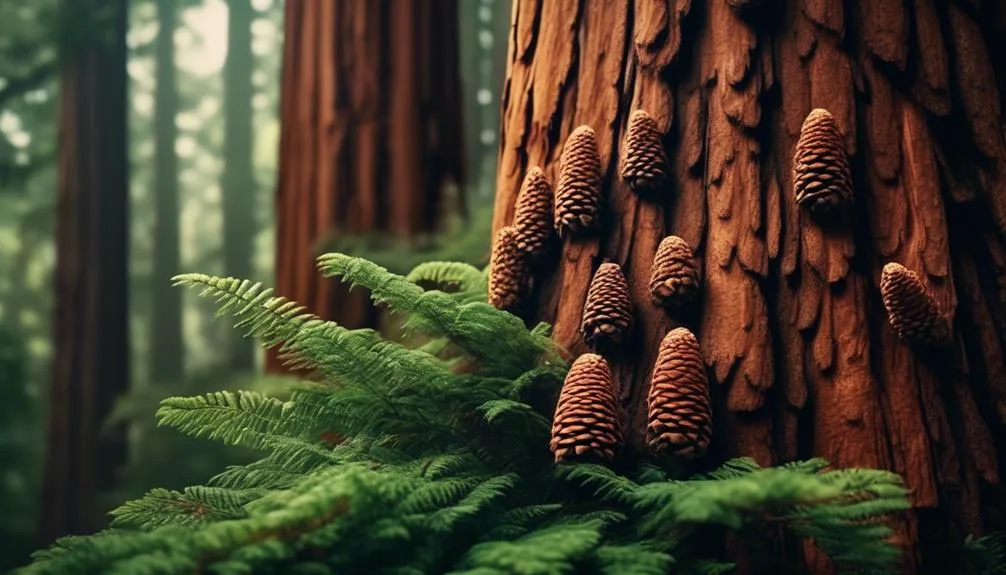Redwood trees, despite their grandeur, produce surprisingly small cones. Have you ever wondered why?
As you stroll through a redwood forest, the mystery of these tiny cones may spark your interest.
The reason for this lies in how these massive trees have adapted over time and how they disperse their seeds.
Stay tuned to explore the secrets behind the small cones of these towering giants.
Redwood Tree Reproduction
Redwood trees reproduce through a fascinating process that involves both male and female cones, each playing a crucial role in the tree's reproductive cycle.
The conifer life cycle of redwood trees begins with cone development, where the male cones release pollen, which is then carried by the wind to the female cones. This process may take up to a year, and once the female cones are fertilized, they begin to develop seeds.
It's incredible to witness this intricate dance of nature, as the cones mature and eventually release their seeds, enabling the cycle to begin anew.
This conifer life cycle is essential to the survival of redwood trees and ensures their continued existence for generations to come.
Evolutionary Adaptation
Amidst the towering majesty of the redwood forests, the evolutionary adaptations of these remarkable trees reveal a captivating story of survival and resilience. Redwoods have evolved to thrive in their specific environment through natural selection, resulting in various adaptations that give them a unique advantage in the face of challenges.
One notable adaptation is their small cones, which play a crucial role in their resilience. This evolutionary advantage offers climate resistance and aids in their continued survival. The smaller cones allow the redwoods to disperse seeds more effectively, increasing the likelihood of successful reproduction. Additionally, the reduced size minimizes energy expenditure, enabling the trees to allocate resources more efficiently.
This adaptation showcases how evolution has equipped redwoods with remarkable strategies for enduring and thriving in their environment.
- Efficient seed dispersion
- Minimized energy expenditure
- Enhanced resource allocation
- Greater reproductive success
- Improved climate resistance
Environmental Factors
As we explore the environmental factors influencing the redwood trees, it becomes evident that their remarkable adaptations are intricately intertwined with the surrounding ecosystem, shaping their resilience and survival strategies.
The climate exerts a significant influence on the redwood trees, with the coastal fog playing a crucial role in maintaining their moisture levels, particularly during the dry summer months. This ecological role of the coastal fog is vital for the redwoods, as it prevents desiccation and helps sustain their towering stature.
Furthermore, the mild temperatures and abundant rainfall in the redwood's habitat contribute to their ability to produce small cones, as these conditions provide the necessary resources for cone development.
The redwood's ecological success is thus closely tied to the climate influence and the interplay of various environmental factors, highlighting their adaptability and resilience in their unique ecological niche.
Seed Dispersal Strategy
Nestled among the towering redwood trees, the small cones play a crucial role in the seed dispersal strategy, ensuring the continuation of the redwood's lineage in their unique ecosystem. The cone size and dispersal mechanism are key factors in the redwood's seed dispersal strategy.
- Wind: The small size of the cones allows them to be easily carried by the wind, aiding in dispersing seeds over a wide area.
- Animal Transport: Small cones are more likely to be carried by birds or small mammals, aiding in seed dispersal to distant locations.
- Water: Small cones can float, facilitating seed dispersal across water bodies and promoting genetic diversity.
- Protection: Small cones are less conspicuous, offering protection to the seeds from potential predators.
- Adaptability: The small size of cones allows for efficient dispersal in the dense, shaded environment of the redwood forest.
Genetic Characteristics
Playing a critical role in the seed dispersal strategy, the genetic characteristics of redwood trees contribute to their remarkable resilience and adaptability within their ecosystem. Genetic mutation plays a key role in the development of small cones in redwood trees.
This mutation results in the production of smaller cones, which have proven to be advantageous for the trees. The smaller cones allow for more efficient dispersal of seeds, increasing the likelihood of successful reproduction and survival of the species.
Additionally, the genetic makeup of redwood trees also influences cone size, as certain genetic characteristics determine the size of the cones produced. This adaptability through genetic characteristics enables redwood trees to thrive in diverse environmental conditions, ensuring their continued presence and dominance in their natural habitat.
Conclusion
In nature, the redwood tree's small cones are a testament to its enduring adaptation and resilience over millions of years.
Their role in reproduction and seed dispersal highlights the intricate balance between genetic traits and environmental factors.
As we marvel at these majestic trees, we're reminded of the power of evolution and the remarkable strategies that enable species to thrive.
Mark Hoffman is a dedicated arborist and tree care specialist with over a decade of experience. His love for trees began when he visited Yosemite National Park as a teenager and was awestruck by the giant sequoias. Mark pursued his passion by studying forestry at Michigan Technological University, where he earned a Bachelor of Science degree.
Since then, he has worked tirelessly in the field of arboriculture, helping to preserve and protect trees in his community. His expertise and dedication have made him a respected leader in the industry and a valuable resource for anyone seeking advice on tree care.
